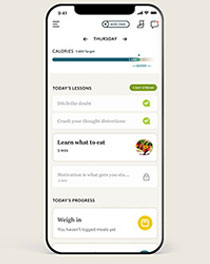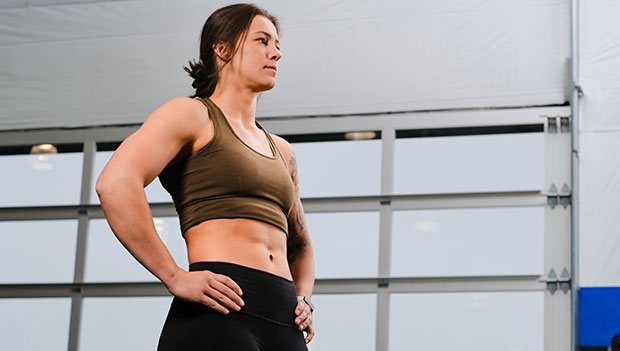
By clicking on the product links in this article, we may receive a commission fee at no cost to you, the reader. Sponsorships and affiliate commissions help support our research so we can help you find the best products. Read our full affiliate disclosure here.
When it comes to learning how to get abs, two key factors are crucial—passion and patience. It's fair to say that almost everyone that wants a six-pack is passionate about it. It’s the second word, patience, that can be the issue. In this fast-paced environment, people that just started training want to see their abs yesterday.
You can't get abs if you have poor eating habits. Re-train your brain with help from NOOM.
The simple fact is that having a ripped midsection won't happen overnight but learning how to build abs and applying those strategies as consistently as possible can help you reach your goal faster. Additionally, having a sound nutrition plan, training hard, performing regular cardio, and being consistent is the perfect formula to get you there. Here are the most effective training strategies to help make your six-pack aspirations your new reality.
Nutrition
The first thing people wondering how to get abs should know is that you have to have a low body fat percentage in order to see your abs. In terms of a number, the percentage goals that can help get you there are 10 percent for men and 12 percent for women. So, if your body fat percentage is higher, you will have some work to do if a six-pack is your end goal. Losing body fat and getting ripped won't be easy, but the principle behind the practice is simple.
Calories out must be greater than calories in.
In other words, if you consume more calories than you burn, then everything else you’re doing training-wise won’t help get you there. Of course, that doesn’t mean you can eat whatever you want in smaller portions. The food that you eat matters.
Diet
Several healthy diet plans can apply to all walks of life—Atkins, Paleo, Keto, etc. While the choices vary, finding a program that can help you stay consistent will go a long way toward making your road to a six-pack easier to travel.
Protein: The most important part of your nutrition plan should be protein. Protein is what helps you build and maintain muscle. Your abdominals will need protein to grow, and plenty of it. Every meal you eat should have a quality protein source. This source can come from food like poultry, eggs, fish, and lean beef or in the form of supplemental protein shakes. Though, keep in mind that while protein shakes are an excellent option for after your workout or when you need to have a meal quickly, they shouldn't be the foundation of your daily protein intake. Four calories make up one gram of protein per pound of bodyweight, which many trainers consider the sweet spot. So, a 180-pound person should aim for 180 grams of protein per day.
Fats: The next macronutrient to pay attention to is fat. Yes, fat. Unsaturated fats are beneficial to your diet because they help improve blood cholesterol levels and keep your heart rhythm stable. Both of those benefits alone make them worth adding to your meal plan.
It takes nine calories of fat to equal one gram. Eating 0.3 grams of healthy fats per pound of bodyweight would be sufficient to benefit you, but it wouldn’t be so much that you feel overwhelmed. If you weigh 180 pounds, that will equal 60 grams of fat per day.
Carbohydrates: Then, there are carbohydrates, which are valued at four calories for every gram. Believe it or not, cutting carbs out of your diet isn’t the answer for most people. Carbohydrates, when consumed properly, can help fuel your performance, which is a big deal when it comes to getting ripped. The sources and timing of those carbs can be the factor in mastering how to get abs.
The best carbohydrate sources include oats, sweet potatoes, rice, whole grains, fruits, and vegetables. The best starting point for an effective carb strategy is to have one gram per pound of body weight. So, our 180-pound athlete would also need 180 grams of carbs.
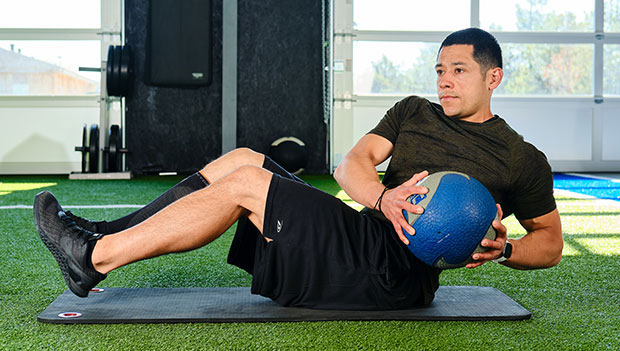
Putting it Together
If you were to take the numbers for the 180-pound person mentioned, the macronutrients for their daily diet would be 180 grams of protein, 180 grams of carbs, and 60 grams of fat. The next question is, how do those totals get broken up per meal?
Two methods prevail when it comes to meal planning. The first is having five to six meals a day because the digestive system won't become overwhelmed, and you'll stay fueled for the entire day. If you were to break those macros up into six meals, that would be 30 grams of protein, 30 grams of carbs, and 10 grams of fat for each meal.
The other method is eating three larger meals per day to keep the body satisfied longer. If our 180-pound friend were to go with the classic "three squares a day," then the macros for those meals would be 60 grams of protein, 60 grams of carbs, and 20 grams of fat.
Try both and figure out which method works best for you. Which meal plan helps you perform better in training, keeps you satisfied, and most importantly, helps you stay consistent? That is the best meal plan for you.
Water
Every part of your body needs water. It is the most important thing you will consume, but that doesn’t mean water is the only thing you can drink. Feel free to have your coffee every morning, and we’ve already covered protein drinks.
That said, the first and last beverage you should have every day is water. Staying hydrated is vital to helping you lose body fat and build your muscular six-pack. Water is calorie-free and will fuel both your muscles and metabolism. So, keep that water bottle or shaker bottle handy.
Active people need more water because of the demands placed on the muscles. Fortunately, figuring out how much to drink is simple. Take the number of your body weight in pounds and cut that number in half. Remember our 180-pound friend from earlier? That person would need 90 ounces of water a day.
One issue that people typically run into with drinking so much water is frequent bathroom trips. Nobody wants to get up in the middle of the night because they have to go again. Start by drinking water first thing in the morning, as drinking 16-20 ounces when you first get up knocks out a lot of that requirement early. Then drink water with each meal and during training. By the time dinner rolls around, eight ounces will finish the day off, and you should be able to sleep throughout the night.
Sleep
Getting adequate rest is a significant part of your recovery and directly translates to the results you will see. Massages, chiropractor visits, stretching, and recovery supplements can all be helpful, but without a good night of sleep, you're just spinning wheels and going nowhere.
Eight hours of sleep is considered the gold standard, but nine would be even better for athletes and very active folks. The bare minimum that you should get is six hours every night. That is six continuous hours—not four with a nap later on, and getting that sleep on a quality mattress matters.
If you have trouble sleeping at night, try making the room completely dark. Try to stay away from TVs or cell phones because the blue light will keep you awake. Also, do your best to go to bed at the same time every night. You have an alarm for waking up. Set another for bedtime. As with nutrition and working out, consistency is the key to success.
Ab Training
Knowing how to build your abs means knowing what to do when it's time to train. Having a great six-pack means building muscle. You can accomplish this through both direct and indirect training. Performing regular cardio can help you burn those extra calories and keep your metabolism high, which will then help you reduce your body fat so you can eventually see those cuts.
Ab Exercises
There are several great ab exercises to perform to target the upper and lower abs and the obliques when you train. The workout listed below can be completed at home or in a gym and should take you about 10-20 minutes.
Twisting Sit-ups
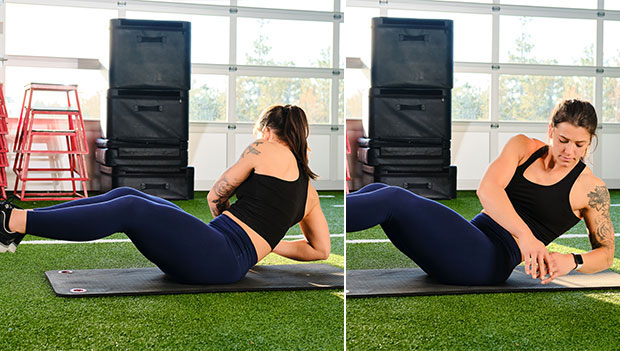
Lie on your back with your knees bent and feet flat on the floor. Place your hands on the sides of your head (don't clasp them) and flare your elbows out. Using your ab muscles, sit up and turn so that your right elbow reaches towards your left knee. If they touch, great, but don't force it. Once you feel the contraction, lower yourself back down and repeat the opposite way.
Reverse Crunch
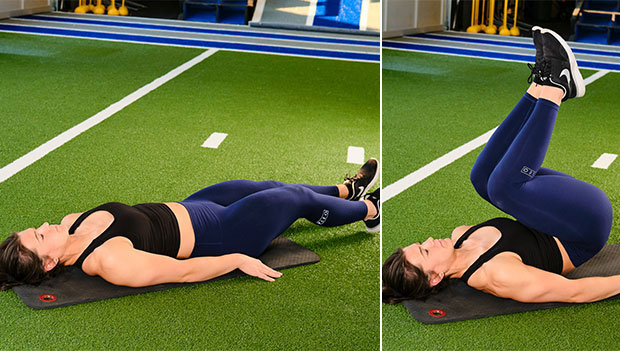
Lie on your back with your legs straight and your hands under your lower back. Raise your legs so your heels are slightly off the floor. Raise your head so it is slightly elevated as well. Lift your legs straight up until your hips come off the floor. Lower yourself back down to the starting position and repeat.
Side Plank with a Dip

Place either elbow directly underneath your shoulder and place yourself into a side plank position. Lower the hip until it's slightly above the floor, but don't let it touch the floor. Use the strength in your core to lift your hips back to the starting position and repeat. Once you perform all the reps on one side, repeat with the other.
Ab Workout Circuit
Perform all three exercises in order as a circuit. Rest 30 seconds after the first round and then repeat. Perform three to five total circuits, depending on your level of experience.
- Twisting sit-ups: 10 reps, per side (20 total)
- Reverse crunch: 10 reps
- Side plank with a dip: 10 reps, per side (20 total)
Indirect Ab Training
There are other ways to train your abs outside of performing direct abdominal work. Bracing your core during squats or overhead presses is considered indirect ab work. Anytime you keep your stomach tight while sitting upright in a chair or on an exercise ball, that is also indirect ab work. Find unique ways to incorporate this movement into your day, and your ab training will progress quickly.
Cardio Training
Then, there’s cardio. The two forms of cardio used the most are—high-intensity interval training (HIIT) and low-intensity steady state (LISS).
HIIT is when you alternate bouts of all-out effort with low effort or rest. Most athletes like HIIT because—in addition to burning more calories—it challenges the muscular system and endurance, which transfers to other forms of fitness. Examples of HIIT could involve sprints, boxing drills, or alternating speeds on a bike. These sessions are usually 10-30 minutes in length.
LISS calls for a more consistent and moderate effort from start to finish. These workouts are traditionally longer sessions—ranging from 20 to as many as 60 minutes. It takes longer to burn calories this way, but it’s considered easier for recovery.
You can perform your cardio training either in the morning or after a weight training session. You can also alternate HIIT with LISS sessions to keep your programs interesting. The only hard rule is not to perform cardio immediately before weight training. Your glycogen storage gets used up during cardio and can diminish your training efforts in the weight room.
Benefits of Building a Strong Abdomen
Whether your goal is to look ripped or maximize your performance, knowing how to build your core will ultimately help you. Having a strong set of abs can maximize stability, improve posture, lessen back pain, and decrease the risk of suffering an injury. A strong core can be your greatest ally, regardless of your training goals.
Best Ab Exercises | How to Get a Six-Pack | Lower-Ab Workouts | Workouts for Women | Workouts for Men | Plank Exercises | Best Ab Machines | 30-Day Ab Challenge | Best Ab Rollers



